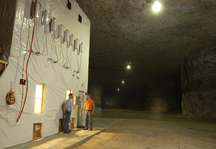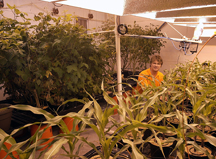
April 20, 2005
Underground crops could be future of 'pharming'
WEST LAFAYETTE, Ind. - Corn grows just as well - if not better - underground as in a typical greenhouse setting or in the field, according to a team of Purdue University researchers that is working with a company to develop techniques for tightly controlled production of crops containing pharmaceuticals such as antibodies.

|
The scientists, in partnership with Controlled Pharming Ventures LLC of McCordsville, Ind., have designed and built a crop-growth facility inside a 60-acre former limestone mine in Marengo, a small town in southern Indiana. The first test crop, planted in the underground facility late last fall, produced more corn in a shorter time period than plants grown in a greenhouse on the Purdue campus, said Cary Mitchell, a Purdue professor of horticulture.
"This first planting performed very well," Mitchell said. "We've shown that you can successfully grow crops underground in a lighted but completely contained facility. What we have here is a perfect model for controlled-environment agriculture. This could jump-start a whole industry."

|
Controlled- environment agriculture is a system in which all the inputs required for plant growth - light, temperature, carbon dioxide and humidity - are regulated to maximize growth.
The team recently presented its results at the NCR-101 annual conference. NCR-101 is a U.S. Department of Agriculture committee dedicated to controlled environment agriculture.
In the initial trial, genetically modified corn grown in the facility had an average yield that equaled 337 bushels per acre. By comparison, corn the researchers grew in a greenhouse yielded the equivalent of 267 bushels per acre.
The average yield for field corn grown in the United States is 142 bushels per acre. The higher yield in the growth facility is a product of the amount of control the researchers have over the environment compared to both greenhouse and field settings. The corn the researchers planted, known as Bt corn, contains a gene that produces a protein that kills larvae of European corn borer, an agricultural pest.
These results lay to rest the team's initial concerns about growing crops in an underground mine.
"Because corn and other pharma crop candidates, such as tobacco and tomato, are naturally hot-weather crops, there was some concern whether the year-round, cool temperatures of the mine would be sub-optimal for crop growth underground," Mitchell said.
It turns out that the growth facility's location in the mine actually puts it at a temperature advantage.
"The design we use leverages the cool air temperatures in the mine to reject waste heat from the intensely hot plant-growth lamps in the facility," Mitchell said.
The underground growth chamber is the brainchild of Doug Ausenbaugh, president of Controlled Pharming Ventures, a startup company funded to develop the facility through the Indiana 21st Century Research and Technology Fund.
Ausenbaugh said the facility's design incorporates safeguards to prevent any release into the wild of plants genetically modified to produce pharmaceutical agents.
"This is a safe, reliable, consistent and contained production environment that can operate year-round and around the clock," he said. "What's unique here is the level of control we have over the environment inside the facility."
Ausenbaugh hopes to see the facility become a prime research, development and production site for companies interested in developing pharmaceutical crops or plants engineered to produce proteins like vaccines and antibodies.
Producing these compounds in plants can be cheaper and easier than conventional methods for pharmaceutical production. Some pharmaceutical companies today are interested in using crops as plant-based "factories" to produce proteins that may be extracted and processed in pill or injectable form.
"We have been talking with a number of plant-based pharmaceutical companies about using our facility design, and we hope to launch pilot growth trials over the next 12 months," Ausenbaugh said.
The underground facility is a tall room built within a cavern in a former limestone mine now used largely as a warehouse facility for the transportation industry. The mine creates an environment in which temperature, humidity, light, airflow and other plant-growth factors are tightly regulated.
Environmental control and containment are crucial to any pharmaceutical crops initiative, Ausenbaugh said. Several organizations, including the American Society of Plant Biologists, recommend that any development of pharmaceutical or other transgenic crops be done in an entirely enclosed environment removed from the food system to prevent any accidental contamination.
Currently, the USDA's Biotechnology Regulatory Services, the agency that regulates genetically engineered organisms, has not established specific protocols for transgenic plant production in contained facilities.
However, the facility does meet strict biosafety criteria established by the National Institutes of Health for the handling of transgenic plants in greenhouses, said Yang Yang, a Purdue research scientist helping to develop the growth facility.
"As it exists today, we have biosafety level two status at the growth facility," he said. "We can easily achieve biosafety level three, and because of the natural containment and control offered by our setting in the mine, it would be significantly less costly than in an above-ground facility."
Biosafety level two, or BL2-P, status requires limited access to the facility and inactivation of "biologically active materials," such as the genes inserted into transgenic organisms, before any plants are disposed of. Biosafety level three, or BL3-P, requires additional safeguards, including a double set of self-closing, locking doors and high efficiency particulate air (HEPA) filters for both incoming and exhaust air.
"The ability to attain biosafety level three at a cost advantage is attractive, given the expanding efforts of biotechnology companies on biodefense issues and the NIH's goal of expanding biosafety level research capacity throughout the United States," Ausenbaugh said.
The 60-acre mine is large enough also to include facilities for processing pharmaceutical plants, Ausenbaugh said.
Processing would render inactive any genes those plants carry to produce compounds, such as vaccines, insulin or antibiotics, preventing the transport of any active transgenic material out of the facility.
"We are ahead of our time in that the research we are doing now can provide very good and important references for guidance on building contained transgenic plant production facilities," Yang said. "The procedures we develop and follow may very well end up as the protocols of NIH, USDA, or the Environmental Protection Agency for future construction of underground facilities."
The pilot facility was designed and built for scalability up to sizes measured in acres.
"The walls are just like a sandwich," Yang said. "In the center is an insulation layer, which helps conserve heat. The walls inside the room are made of reflective materials to bounce back as much light as possible, and the outside of the room is covered in protective material."
Data monitors throughout the facility collect real-time information about temperature, humidity and carbon dioxide levels. These monitors communicate with a computer system that responds to any changes in conditions by adjusting variables such as light intensity or air circulation.
A second growth facility, specifically designed to grow crops that benefit from elevated carbon dioxide levels, such as tobacco, alfalfa and soybeans, will be completed later this spring in the same mine.
Taking the long view, Mitchell sees in this facility the potential to revolutionize the U.S. crop production system, provided the cost of artificial lighting can be minimized. He envisions a system by which such facilities will recoup some of their electricity costs by using plant waste, such as leaves and stems, as a source to create energy that goes back into lighting the facility.
He also predicts facilities like the one in southern Indiana will one day support aquaponics, a system that couples fish farming to hydroponic crop production, or even organic agriculture, in which fruit and vegetable production could be done in an environment that requires no pesticides.
"Eventually, we could see plant-related businesses clustering where a lot of waste biomass is being generated and where there's an opportunity to reclaim energy," Mitchell said.
Writer: Jennifer Cutraro, (765) 496-2050, jcutraro@purdue.edu
Sources: Cary Mitchell, (765) 494-1347, cmitchel@purdue.edu
Doug Ausenbaugh, (317) 598-0525, dausenbaugh@controlledpharming.com
Yang Yang, (765) 496-2124, yang71@purdue.edu
Ag Communications: (765) 494-2722;
Beth Forbes, forbes@purdue.edu
Agriculture News Page
Related Web site:
Cary Mitchell Lab
PHOTO CAPTION
Deep inside an abandoned mine in Marengo, Ind., Westin Rink (at left) and Doug Ausenbaugh operate a growth chamber impervious to outside elements. (Purdue Agricultural Communication photo/Tom Campbell)
A publication-quality photo is available at https://ftp.purdue.edu/pub/uns/+2005/ausenbaugh-mine.jpg
PHOTO CAPTION
Surrounded by beans, tobacco and tomato plants, Doug Ausenbaugh monitors the growth of a new crop of corn grown inside a 60-acre limestone mine in southern Indiana. Ausenbaugh is president of CPV, a startup company funded to develop the facility through the Indiana 21st Century Research and Technology Fund. (Purdue Agricultural Communication photo/Tom Campbell)
A publication-quality photo is available at https://ftp.purdue.edu/pub/uns/+2005/ausenbaugh-mine2.jpg
To the News Service home page